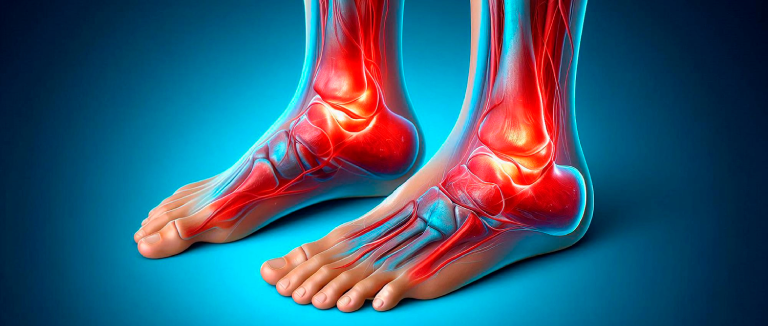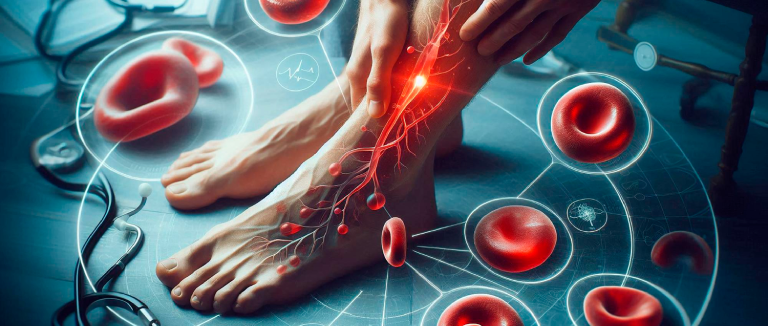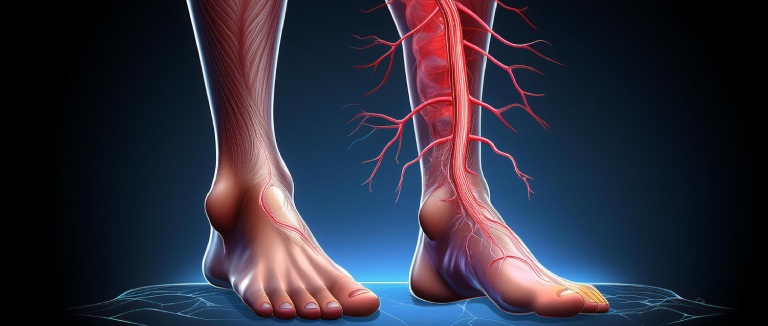
Peripheral vascular disease (PVD) is a condition characterized by the gradual narrowing of blood vessels. It can result from various underlying diseases, with symptoms often including pain and swelling in the affected veins.
What Is Peripheral Vascular Disease and What Are Its Stages?
The leg veins carry oxygen-rich blood from the heart to the arms and legs. Peripheral Vascular Disease, known as PAD for short, is the buildup of plaque in the leg veins. Plaque is a layer of fat, cholesterol and other substances that build up on the vessel wall. Its formation gradually narrows the vessels. Blood clots may form around the plaque, causing further vessel narrowing. If the blood vessels become blocked or narrowed in this way, organs and other tissues cannot get enough blood and cannot be nourished.
There are 5 stages of Peripheral Vascular Disease: asymptomatic, mild claudication, moderate to severe pain, pain at rest, and ulceration or gangrene.
Causes of Peripheral Vascular Disease
One of the most common causes of peripheral vascular disease is peripheral arterial disease resulting from atherosclerosis. Additional causes of PAD include:
- Blood clots: A clot can block an artery and restrict blood flow.
- Diabetes: Chronically high blood sugar can damage arteries, increasing the risk of narrowing or weakness. People with diabetes are also more likely to develop high blood pressure and high cholesterol, which contribute to atherosclerosis.
- Arterial inflammation: Inflammation can narrow or weaken arteries. Infections may affect blood vessels as well as other organs.
- Infection: Certain infections, such as salmonellosis and syphilis, can cause inflammation that blocks, narrows, or weakens blood vessels.
- Structural defects: Congenital structural abnormalities of blood vessels can cause narrowing, even if the underlying cause is unknown.
- Injury: Trauma from events like car accidents or falls can damage blood vessels and contribute to blockage or narrowing.
Risk Factors of Peripheral Vascular Disease
Peripheral vascular disease is associated with several risk factors, including:
- Family history of heart disease, high blood pressure, high cholesterol, or stroke
- Age over 50 years
- Sedentary lifestyle (limited daily movement)
- Overweight or obesity
- Smoking
- Diabetes
- High blood pressure
- High cholesterol
- Previous stroke or heart attack

Symptoms of Peripheral Vascular Disease
One of the most common symptoms of PAD is pain in the calf or buttocks that comes and goes. This pain can be in both at the same time, or sometimes only in one. The pain may occur when walking or climbing stairs and is not felt at rest. The pain can be described as cramping. There may also be a feeling of heaviness, tiredness or tightness in the muscles in the legs. If there is a severe obstruction, leg pain at night is one of the clearest symptoms.
Other symptoms of PAD are as follows:
- Numbness, tingling, or weakness in the legs
- Burning or pain in the feet or toes at rest
- Wounds on the legs or feet that do not heal
- Feeling cold in one or both legs or feet; discoloration (pale, blue, or dark reddish colors)
- Hair loss on the legs
- Thickened toenails
Treatment Options for Peripheral Vascular Disease
Treatment for peripheral artery disease (PAD) focuses on two main goals: reducing the risk of cardiovascular events and improving quality of life by relieving pain during walking. Management may include medications, exercise, and surgical procedures. If PAD is linked to other health conditions, your doctor may prescribe medications to control high blood pressure, cholesterol, and diabetes. Medicines such as cilostazol may be used to increase your walking tolerance and reduce leg pain. In addition, your doctor may recommend an exercise program tailored to your needs to help alleviate leg pain and improve symptoms.
Preventing and Lowering Risk of Peripheral Vascular Disease
The most effective way to prevent peripheral vascular disease is to address and reduce risk factors. You can lower your risk and help prevent the disease by following these steps:
- Quit smoking
- Eat a balanced diet high in fiber and low in cholesterol, fat, and sodium
- Exercise regularly, such as walking
- Manage conditions like high blood pressure, diabetes, and high cholesterol
- Practice stress management (e.g., yoga and meditation)
- Prevent and treat infections
- Achieve and maintain a healthy weight
* Liv Hospital Editorial Board has contributed to the publication of this content .
* Contents of this page is for informational purposes only. Please consult your doctor for diagnosis and treatment. The content of this page does not include information on medicinal health care at Liv Hospital .
Visit Liv Hospitals.

FAQ
Is Peripheral Vascular Disease Dangerous?
The risks associated with PAD depend on the condition's severity, symptoms, and how early it is diagnosed. Early diagnosis and intervention significantly reduce the risks. Effectively managing risk factors also helps minimize the potential dangers of the disease.
What to do if the disease progresses?
If your symptoms of peripheral vascular disease worsen, it is important to consult a doctor. Your doctor will evaluate your condition and may recommend treatment and lifestyle changes. Depending on your needs, you might be advised to take medication, start an exercise regimen, or follow a nutrition plan. Regular check-ups are important to monitor for possible side effects and to support healthy lifestyle changes.
How long does it take to recover after treatment for peripheral arterial disease?
Recovery time after treatment for peripheral artery disease (PAD) varies based on the procedure. For less invasive treatments like atherectomy, recovery usually takes just a few days. In contrast, recovery after angioplasty typically requires a few weeks..
Psychological Effects and Coping Strategies for PAD
Peripheral artery disease can have both physical and psychological impacts. Individuals may experience stress, anxiety, depression, anger, social isolation, and decreased self-esteem. Seeking support from professionals or loved ones can be helpful. Gaining more knowledge about the disease may help you feel more in control. Techniques to reduce stress, such as meditation, and engaging in enjoyable activities can boost positive emotions and improve psychological well-being. Staying connected with family and friends is also important to prevent feelings of isolation.
Diagnosis of Peripheral Artery Disease
Several tests can be used to diagnose peripheral artery disease (PAD), including the ankle-brachial index and vascular ultrasound, which help detect and assess the severity of the disease. Angiography may also be performed to pinpoint the location of blockages. If you or someone you know has symptoms of PAD, it is important to consult a specialized doctor for evaluation.
